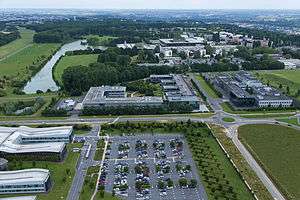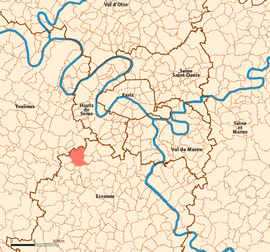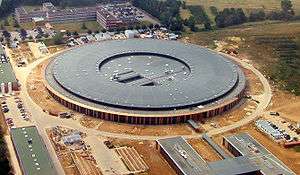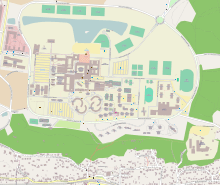Paris-Saclay
 | |
| Established | from 1950's, and to 2020[1] |
|---|---|
Academic staff | 10,500 professors/researchers[2] |
| Students | up to 60,000, including 25,000 in master degree and 5,700 PhD students[2] |
| Location | several neighboring cities and places (Plateau de Saclay, Saint-Quentin-en-Yvelines, Versailles, Massy, Essonne, vallée de l'Yvette), Île-de-France, France |
| Affiliations |
|
| Website |
www |
Paris-Saclay is a research-intensive and business cluster currently under construction south of Paris, France. It encompasses research facilities, universities, French higher education institutions (grandes écoles) and also research centers of private companies. In 2013, the Technology Review put Paris-Saclay in the top 8 world research clusters.[3] In 2014, it comprised almost 15% of French scientific research capacity.
The earliest settlements are from the 1950s, and this area was subsequently extended several times during the 1970s and 2000s. Several projects are underway to continue the development of the campus, including the relocation of some facilities. The goal is to strengthen the cluster in order to build an international scientific and technological hub that can compete with other high-technology business districts, such as Silicon Valley or Cambridge, MA. This project started in 2006 and is likely to end in 2020. The main part is the construction of the campus du plateau de Saclay (in English plateau de Saclay campus), in order to launch the Université Paris-Saclay.
History
First post-war settlement
Several French national institutions settled on the plateau after the end of World War II. The CNRS is the first to settle there, headed by Frédéric Joliot-Curie, who bought the estate Button at Gif-sur-Yvette in 1946.[4] The following year, the newly created CEA (the High Commissioner is also Joliot-Curie) to purchase land. The same year, ONERA settles on the plateau in Palaiseau. The Saclay center was inaugurated in 1952.[5][6]
At the same time, higher education institutions settled nearby. The University of Paris is also up in the region in 1955 with the purchase of 50 hectares in the communes of Orsay and Bures. This Orsay campus brings laboratories of the Paris Faculty of Sciences (later the University of Paris-Sud) and moved to 1956. Other institutions followed with the installation of HEC in 1964 with its move to the town of Jouy-en-Josas, then with the arrival of the École supérieure d'optique in 1965 on the Orsay campus.[7]
Research centers related to private companies also settled at that time in 1968 with the arrival of the Central Research Laboratory of Thomson-CSF.[7]
Second wave of settlement in the 1970s
In the 1970s, the École polytechnique and Supélec settled on the plateau,[7] the first in 1976 in the Palaiseau area, the other in 1975 in the Moulon area. The project had a scheduled time to install other schools soon after. The Moulon farm which currently houses the genetics and plant breeding was restored in 1978.[7]
Institutions on the plateau at this time begin to join together in an association d’établissements scientifiques (association of scientific institutions, AES) to reflect future developments of the area.[7]
Third wave of the 2000s
At the beginning of the twenty-first century, research centers of private companies settled on the campus. In 2000, Danone chooses to establish a center for Research and Development in the area of Palaiseau,[8] joined in 2006 by Thales laboratories, and in 2009 by Kraft Foods which invests €15 million to install one of its expertise global centers.[9] Other projects removal were also studied, including a research center of EDF, studied in 2010.[10]
Two thematic advanced research are also on the campus, with the creation of Digiteo and Triangle de la physique in 2006. SOLEIL, which creation was decided in 2000[11] after three years of opposition of Claude Allègre,[12] was inaugurated the same year, built with a budget of 313 million euros.[13] The project of neuroimaging center NeuroSpin is launched in 2006 also on the plateau.[14]
The first building constructed specifically for the campus is the Pôle commun de recherche en informatique (Joint Research Cluster Computing), which was inaugurated in November 2011.[15]
Development projects
The proposed new construction and renovation of campus was launched by President Nicolas Sarkozy who wants to create a "French Silicon Valley". The entire project is estimated to three billion euros funding.[16]
The different steps to set up the campus are part of several government operations.[7]
- The opération d'intérêt national de Massy Palaiseau Saclay Versailles Saint-Quentin-en-Yvelines is established in 2006. Larger than the campus, it provides for the creation of a science and technology cluster on the Saclay plateau.[17] It is supported by "Grand Paris" project which also provides that the campus is accessible by the Ligne verte du Grand Paris Express.
- The "plan campus" permits an investment of 850 million euros.[18]
- With the debt, a billion is invested. Saclay campus is one of the winners of the « initiatives d'excellence » project so was awarded another grant of 950 million of euros.[19] 30 October 2012, Jean-Marc Ayrault confirmed for the future operation of the project Campus Paris-Saclay staffing a billion for real estate transactions designed to bring together institutions, 850 million from plan campus and additional billion for investments for the future.[20]
Several institutions of higher education will be moved on the campus, such as:
- the École Normale Supérieure de Cachan[21]
- ENSTA ParisTech,[22]
- Agro ParisTech. Particularly, AgroParisTech and INRA have a project for the construction of a common building in Palaiseau. It will include all activities INRA Île-de-France unlocated in Jouy-en-Josas or Versailles.[23]
- École Centrale Paris
- ENSAE ParisTech
- Télécom ParisTech which moves was confirmed in September 2010,[24]
- and all or part of the University of Paris-Sud.[25]
Along with other institutions already located in the cluster, these education institutions are to be merged in University of Paris-Saclay. This university is to enter the Shanghai ranking between the 10th and 20th position.[26]
In February 2001, the Versailles Saint-Quentin-en-Yvelines University became a founding member of the scientific cooperation foundation foreshadowing the future campus on the Saclay plateau.[27] In November 2011, the Mines ParisTech finally withdrew the project.[28]
Three administratives structures have been created for this project:
- The Établissement Public Paris-Saclay, chaired by Pierre Veltz.[29]
- The Fondation de coopération scientifique Plateau de Saclay is the structure that carries the project. It must unite the various institutions at the university and scientific level. It is successively chaired by Alain Bravo, Paul Vialle[30] (28 April 2009 to his resignation on 30 March 2011[31]) and Dominique Vernay.[32]
- The consortium des établissements du Plateau de Saclay, which brings together 23 institutions.
Companies established at Paris-Saclay
- ABB
- Agilent Technologies
- Airbus Group
- Air Liquide
- Alstom
- Altera
- Blizzard Entertainment
- BMW
- Boston Scientific
- Bull
- Capgemini
- Cardinal Health
- Carrefour
- Casio
- Danone
- Dassault Systèmes
- Dentsply
- EDF
- Eni
- Ericsson
- General Electric
- GSK
- Hitachi
- Honeywell
- Horiba
- HP
- Iron Mountain Inc.
- Kraft Foods
- Kyocera
- LFB
- Malakoff Médéric
- Mercedes-Benz
- Mettler-Toledo
- Molex
- Nexter
- Nokia
- Oracle
- PSA Peugeot Citroën
- Reckitt Benckiser
- Renault
- Safran
- Sanofi
- Schindler
- Siemens
- SFR
- Telindus
- Thales
- Thermo Fisher Scientific
- UTC Aerospace Systems
- Valeo
- Volvo
Town planning
Areas of the campus


The campus has currently seven areas:[33]
"Gif-sur-Yvette" area
The French National Centre for Scientific Research is located at Gif-sur-Yvette since 1946. The area has a dozen research units and service, and also 1,500 people.[34]
"Jouy-en-Josas" area
HEC Paris has been located at Jouy-en-Josas since 1964. INRA has 1,400 people in the area, and facilities for experimentation on livestock and microbiology. An extension of these activities provided for the arrival of more than 300 people in 2012, with the construction of Biosafety P3 facilities for virology.[35]
"Martinière" area
The « Martinière area » is at the center of the whole, between the areas of Palaiseau and Moulon. It should accommodate several components of the University of Paris-Sud (earth sciences, economics and management, law and sport) as part of the development in the 2010s, but also several facilities pooled projected by the campus operation (conference center, students and international doctoral students accommodation centers, home business, documentation, logistics).[36]
"Moulon" area
The area includes Supélec and a part of the University of Paris-Sud, which has 1,160 people in the area including 860 students. The École Centrale Paris, the École Normale Supérieure de Cachan and part of the University of Paris-Sud should relocate there. There should then be around 8,100 staff, 5,000 students for engineering schools and 5000 students in the University of Paris-Sud.[37]
"Orme/Saclay" area
It includes the Saclay Nuclear Research Centre, the Orphée reactor and SOLEIL in Saint-Aubin.
"Palaiseau" area

The area includes the École Polytechnique, the ENSTA ParisTech, the Office National d'Études et de Recherches Aérospatiales and the École supérieure d'optique. It would bring together ParisTech grandes écoles in the project developed in the early 2000s : Agro ParisTech, the ENSAE ParisTech and Telecom ParisTech.[38]
"Nozay" area
Projects critics
Various extensions of the campus were criticized by environmental movements in the early 1990s who accuse it of reducing the size of the agricultural areas.[39][40] These criticisms are reformulated in the expansion projects of the 2000s.[41]
Some also criticize a project that promotes the Grandes Ecoles too much, especially with regard to the governance of the Campus.[42] The Snesup (Syndicat national de l'enseignement supérieur) denounces "a project based on an elitist vision of higher education" and the exclusion of many institutions from the Board of Directors.[43] The management project initiated by the "campus plan" has also been criticized by local politicians who criticize the state for being the sole leader of the project,[44] or other project stakeholders who criticize the state of exercising too much intervention.[45]
The organization referred to as a business cluster is also criticized by the actors who doubt its effectiveness or fear that its development would be detrimental to other geographical areas, as in the case of the University of Paris-Sud and the École Normale Supérieure de Cachan leaving towns in the Paris region,[46] or in the case of grandes écoles leaving Paris.[47]
See also
- Plateau de Saclay
- Business cluster
- Research-intensive cluster
- Research park
- Science park
- List of technology centers
Bibliography
- Plan Campus du plateau de Saclay, Tome 1, Paris, March 2009, 65 p.
- Plan Campus du plateau de Saclay, Tome 2, Paris, March 2009, 115 p.
References
- ↑
- 1 2 "Paris Saclay". Epps.fr. Retrieved 6 November 2016.
- ↑ Regalado, Antonio. "Infographic: The World's Technology Hubs". Technologyreview.com. Retrieved 6 November 2016.
- ↑
- ↑ "Histoire du centre de Saclay / Présentation générale / CEA Saclay - CEA Saclay". Centre-saclay.cea.fr (in French). 2012-07-17. Retrieved 2016-11-06.
- ↑ "Abonnement Le Monde". Lemonde.fr. Retrieved 2016-11-06.
- 1 2 3 4 5 6
- ↑ "Abonnement Le Monde". Lemonde.fr. Retrieved 2016-11-06.
- ↑ "Magazine". Challenges.fr. Retrieved 2016-11-06.
- ↑ http://www.leparisien.fr/saclay-91400/edf-envisage-de-demenager-sur-le-campus-18-05-2010-925962.php
- ↑ "Abonnement Le Monde". Lemonde.fr. Retrieved 2016-11-06.
- ↑ "Soleil a (enfin) rendez-vous avec Chirac - Libération". Liberation.fr. 2006-12-19. Retrieved 2016-11-06.
- ↑ "Soleil va bientôt voir le jour - Libération". Liberation.fr. 2006-06-29. Retrieved 2016-11-06.
- ↑ "Coup d'envoi vendredidu projet NeuroSpin - 24 novembre 2006 - L'Obs". Tempsreel.nouvelobs.com. 2006-11-24. Retrieved 2016-11-06.
- ↑ "Journal Le Républicain - Hebdomadaire de l'Essonne". Le-republicain.fr. 2014-06-20. Retrieved 2016-11-06.
- ↑ "Saclay, 22.000 étudiants, 9.500 chercheurs". Latribune.fr. Retrieved 2016-11-06.
- ↑
- ↑ "Opération du plateau de Saclay - ESR". enseignementsup-recherche.gouv.fr. Retrieved 2016-11-06.
- ↑ Jean-Philippe (2012-03-15). "Idex : Les dotations des cinq lauréats de la seconde vague - Educpros". Letudiant.fr. Retrieved 2016-11-06.
- ↑
- ↑ "Sarkozy veut délocaliser Normale sup - le Parisien". Leparisien.fr. 2009-12-15. Retrieved 2016-11-06.
- ↑ Catherine Gaudenz (2009-06-19). "L'école high tech du ministère de la Défense rejoindra Saclay en 2010". Latribune.fr. Retrieved 2016-11-06.
- ↑
- ↑ "Sarkozy annonce l'arrivée d'écoles de prestige sur le campus Paris-Saclay - le Parisien". Leparisien.fr. 2010-09-24. Retrieved 2016-11-06.
- ↑ Jean-Philippe (2008-11-14). "Saclay : Christian Blanc avance son cluster - Educpros". Letudiant.fr. Retrieved 2016-11-06.
- ↑ "Avec Paris-Saclay, l'université française veut prendre du galon". La-croix.com. 7 January 2014. Retrieved 6 November 2016.
- ↑
- ↑ Jean-Philippe (2011-11-10). "Les mines de Paris jugent incompatible l'Idex de Saclay avec le projet ParisTech - Educpros". Letudiant.fr. Retrieved 2016-11-06.
- ↑ Sylvain Allemand. "Media Paris Saclay". Media-paris-saclay.fr (in French). Retrieved 2016-11-06.
- ↑ "Communiqué de presse - Campus Saclay Nomination Paul Vialle". Slideshare.net. Retrieved 2016-11-06.
- ↑ Jean-Philippe AMMEUX (2011-03-31). "Démission de Paul Vialle, le président du campus de Saclay - Educpros". Letudiant.fr. Retrieved 2016-11-06.
- ↑
- ↑
- ↑
- ↑
- ↑
- ↑
- ↑
- ↑ "Abonnement Le Monde". Lemonde.fr. Retrieved 2016-11-06.
- ↑ "Abonnement Le Monde". Lemonde.fr. Retrieved 2016-11-06.
- ↑ "Sur le plateau de Saclay, les derniers paysans de Paris". Lemonde.fr. Retrieved 2016-11-06.
- ↑
- ↑ "Plateau de Saclay : en force, sans consultation | SNESUP". Snesup.fr (in French). 2010-09-29. Retrieved 2016-11-06.
- ↑ "Saclay : un projet critiqué - Libération". Liberation.fr. 2009-04-28. Retrieved 2016-11-06.
- ↑ "Plateau de Saclay : un territoire d'exception mérite un projet d'exception, par Thomas Lamarche et Olivier Réchauchère". Lemonde.fr. 2016-10-14. Retrieved 2016-11-06.
- ↑ "Cécile Duflot se prononce contre la " Silicon Valley " - le Parisien". Leparisien.fr. Retrieved 2016-11-06.
- ↑ "Nicolas Sarkozy confirme le transfert de grandes écoles à Saclay - Le Point". Lepoint.fr. 2010-09-24. Retrieved 2016-11-06.
External links
Coordinates: 48°42′36″N 2°10′09″E / 48.71000°N 2.16917°E